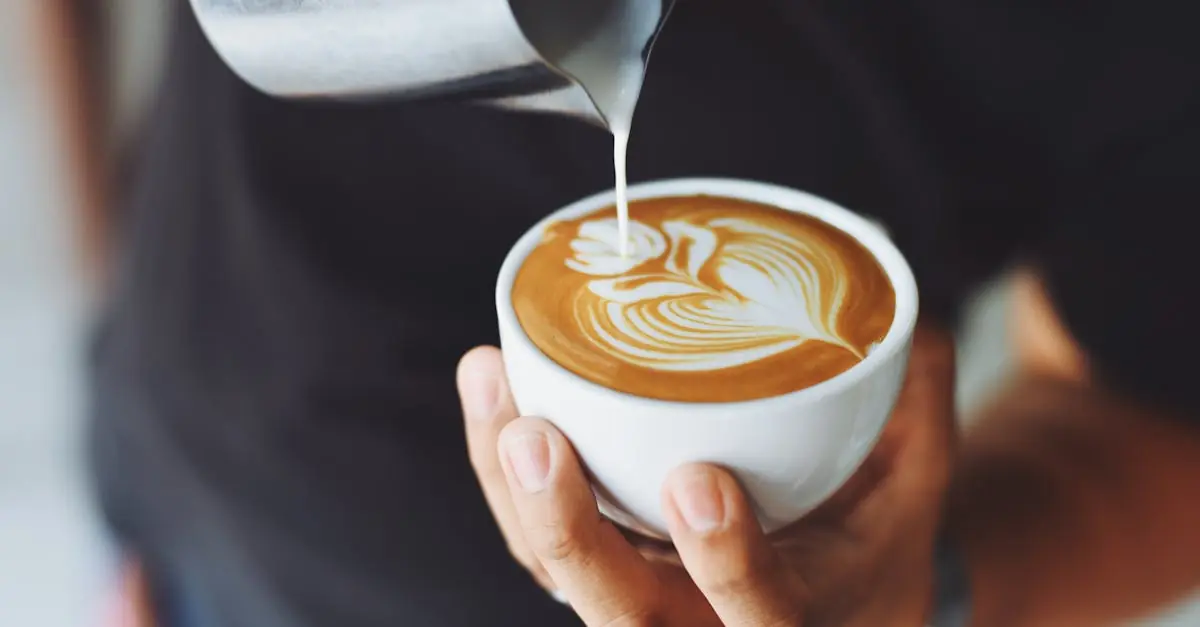Table of Contents
ToggleEver wondered how baristas create those stunning swirls and heart shapes in your morning latte? Latte art isn’t just for Instagram; it’s a delightful combination of skill and creativity that can elevate your coffee game. With a little practice, anyone can transform a simple cup of joe into a masterpiece that’s almost too pretty to drink—almost!
Understanding Latte Art Basics
Latte art combines espresso with steamed milk, creating visually striking designs on top. Mastering this technique requires understanding several foundational elements, including milk texture, temperature, and pouring style.
Texture plays a crucial role in latte art. Achieving microfoam is essential. Microfoam consists of tiny, uniform bubbles that create a velvety texture, allowing for better design creation. Baristas should focus on aerating milk until it reaches a silky consistency.
Temperature also impacts the quality of latte art. Ideal milk temperature ranges from 150°F to 155°F. Heating milk beyond 160°F may negatively affect its sweetness and texture. Therefore, monitoring the temperature during steaming is vital for achieving optimal results.
Pouring style contributes greatly to the final design. Baristas should start with a steady pour, keeping the milk pitcher close to the cup to avoid splashing. Gradually lifting the pitcher higher allows the milk to flow more freely and helps in creating intricate shapes.
Popular designs include hearts, rosettas, and tulips. Each pattern requires specific pouring techniques. For instance, a heart is created by initially pouring from a distance, then bringing the pitcher closer to allow for the desired shape. For a rosetta, a quick back-and-forth motion during the pour is key.
Practice fosters improvement in latte art. Drawing shapes may pose challenges at first. With consistent effort, even novice baristas can develop their skills and create stunning artwork in lattes.
Tools Required for Latte Art
Latte art requires specific tools to achieve the desired results. Baristas must have the right equipment to create beautiful designs in their drinks.
Espresso Machine
An espresso machine serves as the foundation for latte art. It brews concentrated coffee, known as espresso, which provides the necessary base for all designs. Selecting a machine that maintains consistent pressure and temperature ensures optimal extraction of flavors. Various machines, from manual to automatic, can produce high-quality espresso depending on the barista’s skill level.
Milk Frother
A quality milk frother creates the perfect microfoam essential for latte art. Frothers come in different types, including handheld, steam wands, and automatic frothing devices. Each tool introduces air into the milk, producing a smooth texture. The ability to control the temperature and consistency of the milk directly impacts the final appearance of the art, making it a vital piece of equipment.
Pitcher and Thermometer
A pitcher and thermometer play crucial roles in the steaming process. A stainless steel pitcher allows easy maneuverability when pouring milk. The thermometer ensures that the milk reaches an ideal temperature between 150°F and 155°F without overheating. Controlling milk temperature helps create a velvety texture, allowing baristas to form intricate designs with precision.
Milk Frothing Techniques
Mastering milk frothing techniques is essential for creating beautiful latte art. The following subsections explore different types of milk and preferred frothing methods.
Types of Milk
Whole milk produces the creamiest foam due to its higher fat content. This creaminess supports richer flavors in espresso. Skim milk, while lower in fat, creates a lighter foam, making it ideal for beverages that require frothy textures. Almond milk and oat milk offer excellent alternatives for those seeking non-dairy options; however, they may not froth as well as traditional dairy milk. Each milk type presents unique characteristics, affecting taste and texture in lattes. Understanding these differences helps baristas choose the right milk for specific designs.
Frothing Methods
Steam wands are the most common frothing method, utilizing hot steam to incorporate air into the milk. They allow for precise control over temperature and texture. Manual frothers, such as handheld whisks, provide an accessible alternative for home baristas. These require more effort but can yield good results with practice. Automatic frothers simplify the process, producing consistent microfoam without much intervention. Choosing a frothing method largely depends on personal preference and available tools. Each technique requires a focus on creating smooth, airy microfoam to achieve stunning latte art.
Basic Latte Art Techniques
Latte art techniques add an artistic touch to coffee. Mastering specific designs requires practice and attention to detail.
Heart Shape
Creating a heart shape is a popular starting point. Begin with a steady pour, aiming for the center of the cup. As you pour, tilt the pitcher slightly forward. This motion helps the milk integrate with the espresso for a smooth blend. Once the cup fills about halfway, lower the pitcher and move it closer to the surface. A gentle wiggle back and forth produces the desired heart shape. Aim for a thin layer of microfoam on top for better definition. Consistent practice with this technique makes it easier to develop skills over time.
Rosetta
The rosetta design presents a bit more complexity. Start by pouring from a height to create a solid base, filling the cup nearly to the brim. As the cup fills, lower the pitcher to just above the surface. With a gentle back-and-forth motion, drizzle the microfoam to create leaf-like patterns. Control the pour’s speed to ensure a balanced flow that maintains the shape. Once the desired pattern appears, finish with a straight pour through the center to define the design. Practicing this technique enhances overall confidence and creativity in latte art.
Troubleshooting Common Issues
Latte art can be challenging. Addressing common issues helps improve skills and achieve better results.
Poor Milk Texture
Achieving the right milk texture is fundamental. Milk should be frothed to create microfoam, which consists of tiny, uniform bubbles for a creamy finish. Overheating milk may lead to large bubbles and a dry texture. Monitoring temperatures keeps the milk between 150°F and 155°F. Whole milk produces the best microfoam due to its fat content, while alternatives like skim produce lighter foam. If non-dairy options are preferred, using brands specifically formulated for frothing yields better results. Baristas benefit from experimenting with different frothing techniques as they learn to create that ideal, velvety texture.
Inconsistent Patterns
Creating consistent patterns in latte art requires practice. Pouring height and angle greatly affect the outcome; adjusting these can lead to clearer designs. Beginners might find hearts easier, while rosettas require precision and fluid motion. Using a steady pour helps maintain control over the design. If the pattern appears faded or unclear, refocusing on pouring speed is essential. Baristas should also pay attention to the specific type of pitcher used; a narrow spout allows for more detailed designs. Regular practice will lead to improved consistency in shapes and patterns.
Latte art is a captivating blend of skill and creativity that transforms a simple cup of coffee into a visual masterpiece. By mastering the basics of milk texture temperature and pouring techniques anyone can elevate their coffee experience. With the right tools and consistent practice even novice baristas can develop their abilities to create stunning designs.
Embracing the journey of learning latte art not only enhances one’s coffee-making skills but also brings joy to both the creator and the drinker. As they explore various techniques and styles the world of latte art opens up endless possibilities for personal expression and enjoyment.




